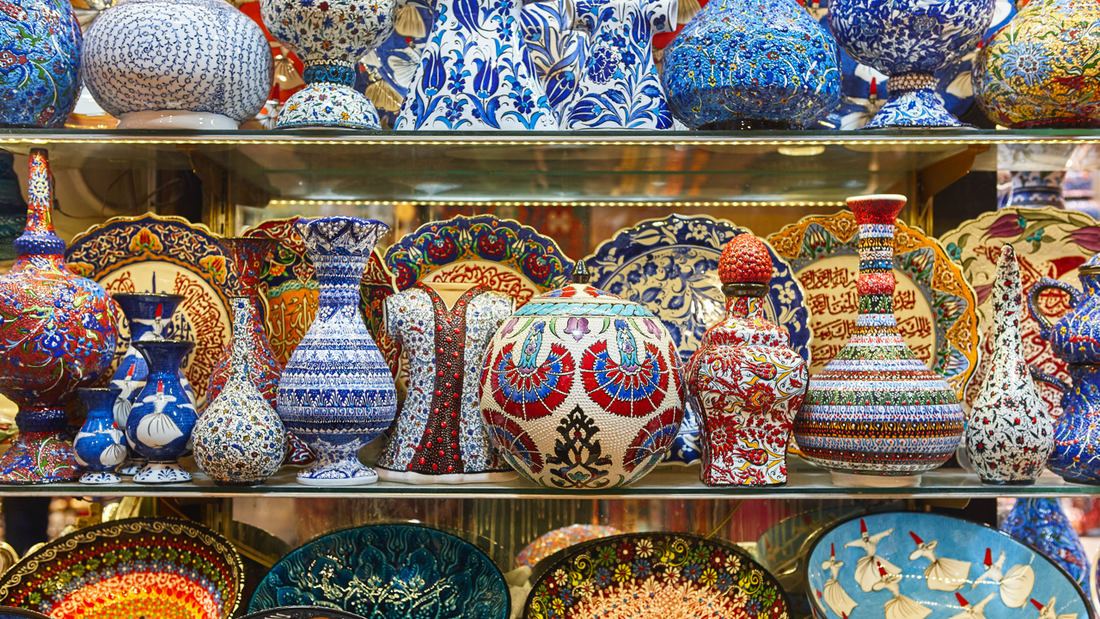
Blue Pottery in Pakistan: History, Significance & Modern Trends
When you think of Pakistan’s rich artistic heritage, few crafts shine as brightly—literally and metaphorically—as blue pottery. With its dazzling cobalt hues, intricate patterns, and centuries-old techniques, blue pottery is not just a decorative art; it’s a cultural emblem that weaves together history, identity, and innovation.
Today, we’ll explore the cultural and historical roots of blue pottery in Pakistan, its significance today, and how modern trends are reshaping its future.
Cultural and Historical Roots
Origins from Persia and Central Asia
Blue pottery’s journey to Pakistan traces back to ancient influences, particularly from Persian, Central Asian, and Mughal traditions. The craft is believed to have originated in the Middle East, where Persian artisans perfected the art of using quartz and glazed surfaces to create vibrant blue tiles and ceramics.
Arrival Through the Mughal Empire
These techniques traveled along the Silk Road, eventually reaching South Asia through the Mughal Empire, whose courts became centers of artistic innovation.
The Local Development in Multan and Sindh
In Pakistan, blue pottery found a home in two key regions: Multan in Punjab and parts of Sindh. Multan, known as the “City of Saints,” became especially famous for its stunning blue tiles adorning shrines, mosques, and palaces. If you walk through Multan’s ancient streets today, you’ll still see the iconic turquoise domes and cobalt mosaics that tell stories of spiritual devotion, architectural mastery, and artistic brilliance.
Historic Uses in Architecture and Decorative Arts
Blue pottery has a deep history in pakistan, it didn’t just serve utilitarian purposes — it actively shaped the visual landscape, becoming a key part of the enduring tradition. Artisans created elaborate tiles, ceramic bowls, ceramic vases, and decorative wall panels, blending floral and geometric patterns with Islamic calligraphy. The vibrant blue and white palette symbolized purity, divinity, and infinite beauty, becoming a hallmark of Pakistani decorative arts.
Cultural Significance Today
A Symbol of National Identity and Pride
In the modern era, blue pottery has retained its cultural weight, evolving from architectural decoration to a beloved symbol of Pakistan’s artisanal heritage. Tourists visiting Pakistan often seek out ceramic souvenirs, not only as mementos but as tokens of the country’s rich cultural fabric.
These intricately designed ceramics—whether a delicate ceramic ornament, ceramic plate, or ceramic wall flower all serve as reminders of Pakistan’s artistic ingenuity.
Connection to Tourism and Cultural Preservation
Beyond tourism, blue pottery holds deep local significance. It connects communities to their past, serving as a tangible link to centuries of craftsmanship and cultural pride.
Artisans in Multan, Sindh, and other ceramic hubs take immense pride in preserving the distinct Pakistani adaptations of blue pottery, which feature local motifs, color variations, and handmade precision.
Role of TEVTA in Supporting Artisans
Organizations like TEVTA (Technical Education and Vocational Training Authority) play a vital role in ensuring this craft does not fade away. TEVTA supports local artisans through training programs, workshops, and resources, helping them refine their skills while preserving the authenticity of the art.
This kind of institutional backing is crucial—not only for cultural preservation but also for boosting local economies.
The Importance of Supporting Handmade Products
When you choose to purchase handmade ceramic products, you’re not just buying a decorative item; you’re investing in small businesses, cottage industries, and entire artisan communities.
Supporting locally made ceramics uplifts families, preserves generational knowledge, and keeps Pakistan’s artistic heritage alive in a world increasingly dominated by mass production.
Modern Adaptations and Trends
Contemporary Designs and Product Innovation
What’s truly exciting is how blue pottery has adapted to the demands of modern life. While traditional items like ceramic jars and ceramic dinner sets remain popular, today’s artisans are creating contemporary products that appeal to younger generations.
Think ceramic tea sets with minimalist designs, ceramic planters for chic urban homes, or even ceramic jewelry that blends heritage with modern fashion.
Innovation Among Young Artisans
This blending of old and new is vital for the craft’s survival. Younger Pakistani artisans are experimenting with new shapes, bolder patterns, and even mixed media, ensuring that blue pottery stays relevant in today’s global market.
E-commerce platforms and global craft fairs have also opened up unprecedented opportunities for artisans to showcase their work internationally, turning local craftsmanship into a global commodity.
Market Challenges and Opportunities
Yet, there are challenges. Artisan communities face market pressures from cheaper, mass-produced goods, and many skilled craftspeople struggle with limited access to modern tools, funding, or marketing channels.
TEVTA has stepped in here too, providing vocational training and business support to ensure that artisans can innovate while maintaining the traditional integrity of their work.
The Use of Natural Materials and Kilns
A key feature that sets authentic blue pottery apart is its reliance on natural materials and age-old processes. Artisans use natural pigments to achieve the signature cobalt blue, carefully mixing minerals by hand.
Traditional kilns, often fueled by wood or gas, are used to fire the ceramics, producing durable, high-quality pieces that carry the unmistakable touch of human craftsmanship.
Why Younger Generations Are Rediscovering Blue Pottery
A Shift Toward Functional Art and Sustainable Living
Younger Pakistani buyers are increasingly drawn to blue pottery not only for its beauty but for its deeper meaning. In a world of fast consumerism, handmade ceramics offer a slower, more meaningful experience.
Whether it’s using a ceramic bowl for breakfast, placing a ceramic table lamp on a bedside table, or decorating a living room with handcrafted ceramic vases, these items bring both function and artistry into daily life.
Environmental Awareness and Local Sourcing
The appeal also lies in sustainability. With rising awareness about environmental impacts, many consumers are moving away from plastics and embracing eco-friendly materials.
Ceramics, being natural, long-lasting, and biodegradable, fit perfectly into this ethos.
Entrepreneurial Innovations and Social Media
Entrepreneurs are tapping into this shift by launching homegrown brands that celebrate Pakistani craftsmanship, often partnering directly with artisans.
Social media and online marketplaces have made it easier than ever for buyers to discover, support, and celebrate the work of these skilled makers.
The Role of TEVTA in Keeping the Craft Alive

Training Programs and Vocational Support
TEVTA’s involvement is crucial in sustaining the future of blue pottery. By offering vocational programs that teach both traditional techniques and modern innovations, TEVTA helps artisans balance heritage with creativity.
This includes training in glazing methods, kiln firing, and even digital marketing to help artisans expand their reach.
Connecting Artisans to Markets
Moreover, TEVTA’s support extends beyond training. By connecting artisans to marketplaces and helping them navigate e-commerce, TEVTA empowers small businesses and cottage industries to scale sustainably.
This ensures that blue pottery does not just survive as a niche craft but thrives as an industry that benefits communities and showcases Pakistan’s artistic heritage to the world.
If you’re looking to support this movement, consider exploring authentic handmade ceramic souvenirs crafted by local artisans. Each piece tells a story of tradition, resilience, and creativity, making it more than just an object—it’s a symbol of living culture.
Preserving a National Treasure
Blue pottery in Pakistan is far more than a decorative art. It’s a living, breathing craft that connects the past to the present and promises a vibrant future.
From its historic roots in Multan and Sindh to its modern adaptations in contemporary homes, blue pottery symbolizes Pakistan’s artistic soul.
With the support of organizations like TEVTA, dedicated artisans are not only preserving centuries-old techniques but also innovating to meet today’s tastes. Whether you’re a local buyer, a tourist, or an international collector, embracing blue pottery means embracing a part of Pakistan’s identity.
So next time you hold a beautifully glazed ceramic vase or admire the intricate patterns on a ceramic plate, remember: you’re holding a piece of history, craftsmanship, and culture in your hands.

